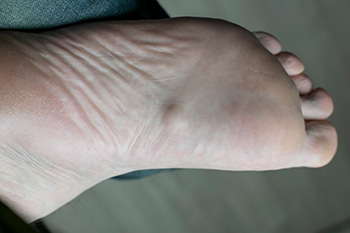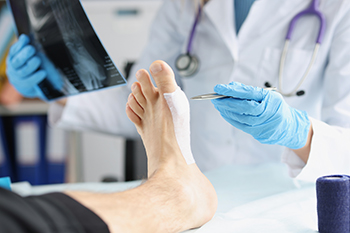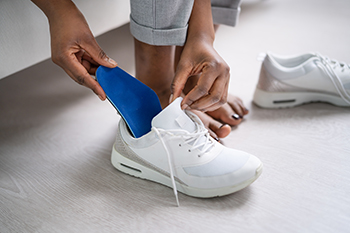Items filtered by date: February 2025
What Is Plantar Fibromatosis?

Plantar fibromatosis is a rare condition that affects the tissue on the bottom of the foot, causing the growth of benign nodules or lumps in the plantar fascia. These lumps are usually firm and may vary in size. The exact cause of plantar fibromatosis is not fully understood, but it may be linked to genetic factors, trauma, or certain health conditions like diabetes or liver disease. Symptoms typically include pain or discomfort in the foot, especially when walking or standing for extended periods. The lumps may gradually increase in size, leading to difficulty in movement or wearing shoes. While the condition is generally not harmful, it can cause significant discomfort. If you lump the sole of your foot, it is suggested that you consult a podiatrist who can provide effective relief and treatment solutions.
A plantar fibroma may disrupt your daily activities. If you have any concerns, contact Leonora Fihman, DPM of California. Our doctor can provide the care you need to keep you pain-free and on your feet.
Plantar Fibroma
A plantar fibroma is a fibrous knot in the arch of the foot. It is embedded in the plantar fascia which is a band of tissue that extends from the heel to the toes along the bottom of the foot. There can be multiple plantar fibromas in the feet at the same time. There are no known causes for this condition. If you have a plantar fibroma, there will be a bump in the arch of your foot that cannot be missed. Any associated pain is most often due to a shoe rubbing against the nodule. Non-surgical options, such as steroid injections, physical therapy, and orthotics should be tried first. Surgery is a last resort and is the only thing that will remove a plantar fibroma entirely. Consult with a podiatrist for a proper diagnosis and to determine the treatment regimen that is right for you.
What Causes a Plantar Fibroma?
While there are no specific causes identified, a plantar fibroma can possibly come from genetic predisposition or the formation of scar tissue that forms from healing the tears in the plantar fascia.
What Are the Symptoms of a Plantar Fibroma?
There will be a noticeable lump in the arch of the foot that may or may not cause pain. If pain is felt, it is typically because a shoe is rubbing up against the lump or when walking or standing barefoot.
Treatment and Prevention
A plantar fibroma will not disappear without treatment, but it can get smaller and be a non-issue. If pain persists, a podiatrist examines the foot and when the arch of the foot is pressed, pain can be felt down to the toes. An MRI or biopsy might be performed to help diagnose or evaluate the plantar fibroma. The following non-surgical options are generally enough to reduce the size and pain of these nodules:
- Steroid injections
- Orthotics
- Physical therapy to help apply anti-inflammatory creams on the bump
Surgery is considered if the mass increases in size and the patient continues to feel pain after non-surgical methods are tried.
If you have any questions please feel free to contact our offices located in Encino and Brentwood, Los Angeles, CA . We offer the newest diagnostic tools and technology to treat your foot and ankle needs.
What Is Ankle Arthrodesis?

Ankle arthrodesis, or ankle fusion, is a surgical procedure that permanently joins the bones of the ankle joint to eliminate pain and improve stability. It is typically recommended for individuals with severe arthritis, post-traumatic damage, or deformities that make walking difficult. When cartilage wears away, bones rub against each other, causing chronic pain and inflammation. Fusion stops this movement, relieving pain but reducing ankle flexibility. Candidates for ankle arthrodesis often include those with end-stage arthritis, previous injuries, or failed ankle replacements. While traditional open surgery is an option, minimally invasive techniques using small incisions and screws have improved recovery times and reduced complications. Although mobility is somewhat limited after fusion, many patients experience significant pain relief and improved quality of life. If chronic ankle pain is interfering with your daily activities, it is suggested that you see a podiatrist who can determine if ankle arthrodesis is the right solution for you.
Foot surgery is sometimes necessary to treat a foot ailment. To learn more, contact Leonora Fihman, DPM of California. Our doctor will assist you with all of your foot and ankle needs.
When Is Surgery Necessary?
Foot and ankle surgery is generally reserved for cases in which less invasive, conservative procedures have failed to alleviate the problem. Some of the cases in which surgery may be necessary include:
- Removing foot deformities like bunions and bone spurs
- Severe arthritis that has caused bone issues
- Cosmetic reconstruction
What Types of Surgery Are There?
The type of surgery you receive will depend on the nature of the problem you have. Some of the possible surgeries include:
- Bunionectomy for painful bunions
- Surgical fusion for realignment of bones
- Neuropathy decompression surgery to treat nerve damage
Benefits of Surgery
Although surgery is usually a last resort, it can provide more complete pain relief compared to non-surgical methods and may allow you to finally resume full activity.
Surgical techniques have also become increasingly sophisticated. Techniques like endoscopic surgery allow for smaller incisions and faster recovery times.
If you have any questions please feel free to contact our offices located in Encino and Brentwood, Los Angeles, CA . We offer the newest diagnostic and treatment technologies for all your foot and ankle needs.
How Custom Foot Orthotics Enhance Treadmill Running

Custom foot orthotics can significantly improve your treadmill running experience by enhancing comfort, reducing injury risk, and optimizing performance. These personalized inserts are designed to correct imbalances in your feet, provide support, and absorb shock, which are critical for the repetitive motion of treadmill running. Running on a treadmill creates a consistent surface that can worsen existing foot issues, such as overpronation, flat feet, or high arches. Custom orthotics work by realigning your foot structure and distributing pressure evenly, which reduces strain on muscles, tendons, and joints. This improved biomechanics leads to smoother movement. A podiatrist can evaluate your gait, identify problem areas, and craft orthotics tailored to your unique needs. If you enjoy running on a treadmill, it is suggested that you schedule an appointment with a podiatrist to discuss whether custom orthotics can benefit you.
If you are having discomfort in your feet and would like to try orthotics, contact Leonora Fihman, DPM from California. Our doctor can provide the care you need to keep you pain-free and on your feet.
What Are Orthotics?
Orthotics are inserts you can place into your shoes to help with a variety of foot problems such as flat feet or foot pain. Orthotics provide relief and comfort for minor foot and heel pain but can’t correct serious biomechanical problems in your feet.
Over-the-Counter Inserts
Orthotics come in a wide variety of over-the-counter inserts that are used to treat foot pain, heel pain, and minor problems. For example, arch supports can be inserted into your shoes to help correct overarched or flat feet, while gel insoles are often used because they provide comfort and relief from foot and heel pain by alleviating pressure.
Prescription Orthotics
If over-the-counter inserts don’t work for you or if you have a more severe foot concern, it is possible to have your podiatrist prescribe custom orthotics. These high-quality inserts are designed to treat problems such as abnormal motion, plantar fasciitis, and severe forms of heel pain. They can even be used to help patients suffering from diabetes by treating foot ulcers and painful calluses and are usually molded to your feet individually, which allows them to provide full support and comfort.
If you are experiencing minor to severe foot or heel pain, it’s recommended to speak with your podiatrist about the possibilities of using orthotics. A podiatrist can determine which type of orthotic is right for you and allow you to take the first steps towards being pain-free.
If you have any questions please contact our offices located in Encino and Brentwood, Los Angeles, CA . We offer the newest diagnostic and treatment technologies for all your foot and ankle needs.
All About Toe Fractures

A toe fracture is a break or crack in one of the bones of the toe, typically caused by direct trauma or pressure. This injury often occurs due to stubbing the toe, dropping something heavy on it, or participating in activities that involve repetitive stress. The common signs of a toe fracture include pain, swelling, bruising, and difficulty moving or bearing weight on the affected toe. In some cases, the toe may appear misaligned or deformed. To diagnose a toe fracture, a podiatrist will perform a physical examination and may take X-rays to evaluate the extent of the damage. Managing the symptoms generally involves rest and elevation. Mild pain relievers can help alleviate discomfort. For more severe fractures, immobilization through splinting or buddy taping is often used. In rare cases, surgery may be necessary to realign the bones and ensure proper healing. If you have fractured your toe, it is suggested that you contact a podiatrist who can properly treat this condition.
A broken toe can be very painful and lead to complications if not properly fixed. If you have any concerns about your feet, contact Leonora Fihman, DPM from California. Our doctor will treat your foot and ankle needs.
What to Know About a Broken Toe
Although most people try to avoid foot trauma such as banging, stubbing, or dropping heavy objects on their feet, the unfortunate fact is that it is a common occurrence. Given the fact that toes are positioned in front of the feet, they typically sustain the brunt of such trauma. When trauma occurs to a toe, the result can be a painful break (fracture).
Symptoms of a Broken Toe
- Throbbing pain
- Swelling
- Bruising on the skin and toenail
- The inability to move the toe
- Toe appears crooked or disfigured
- Tingling or numbness in the toe
Generally, it is best to stay off of the injured toe with the affected foot elevated.
Severe toe fractures may be treated with a splint, cast, and in some cases, minor surgery. Due to its position and the pressure it endures with daily activity, future complications can occur if the big toe is not properly treated.
If you have any questions please feel free to contact our offices located in Encino and Brentwood, Los Angeles, CA . We offer the newest diagnostic and treatment technologies for all your foot and ankle needs.

